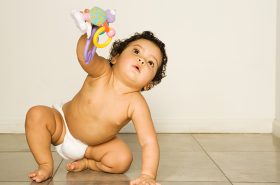
An international study reveals that only one in three women is satisfied with their breasts/chest, leading many to consider cosmetic or reconstructive surgery for enlargement, reduction, lifting, or augmentation. A common concern among these women is the potential impact on their ability to breastfeed post-operation. We would like to take this opportunity to explain to you, to what extent breast/chest feeding is possible at all with breast/chest implants or after a reduction, what the milk production potential depends on and what you can to make the most of it.
Is it possible to Breast/chest feeding with breast/chest implants?
According to the NHS, it is possible for you to breast/chest feed with implants. However, it does depend on the size and placement of the implants and the type of surgery you’ve had. If the incisions are under the fold of the breast or through your armpit, you should not have any problems breast/chestfeeding.
Whether a mother can breast/chest feed depends on the connection between the milk ducts and the nipple being preserved during the operation. If the incision is around the areola, you may have problems as there’s a chance the milk ducts have been cut.
However, this is more likely to be the case with breast/chest reductions.
With breast/chest augmentation, it is particularly advantageous for breast/chestfeeding if the implants are placed under the breast/chest muscle.
This is a little more painful, but it spares the glandular tissue, nerves, blood vessels and the nipple complex. If the implant is placed above the muscle, it can press on the mammary glands, reduce blood supply and have a negative effect on milk production.
In addition, the incision should be made more to the side or under the breast/chest so that the ability to breast/chest feed is preserved. So anyone who wants to have a child should ideally talk to their surgeon about this before having a breast/chest augmentation.
If you have any concerns about breast/chestfeeding – always talk to your midwife or health visitor.

Breast/chestfeeding with breast/chest implants: what should I know?
It is also important to identify the reason for the breast/chest enlargement was in the first place. Was it a result of underdevelopment of the breasts/chest?
In this case, lactation insufficiency may be present. If you have congenital malformation, for example tubular breasts/chest, the mammary gland tissue may be insufficiently developed. It is best to discuss with your doctor what options you have in these cases.
Remember, breast/chestfeeding is great, but there is absolutely no shame in not being able to or not choosing to breast/chestfeed.
There are countless children in this world who have not been breast/chest fed for various reasons and are perfectly healthy.
Does breast/chestfeeding with implants cause deformations?
All breasts/chest change during pregnancy and breast/chestfeeding – especially in terms of firmness and shape. This is completely normal.
However, when the glandular tissue recedes after weaning and is replaced by fatty tissue, many women without implants initially have the feeling that the air has been let out of their breasts/chest. It can take some time before the breasts/chest look “normal” again – in extreme cases up to three years.
Women with breast/chest implants have less of this problem. This is due to a large part of the breast/chest volume consisting of the implant, but this effect is less noticeable when breast/chestfeeding with implants.
Can you breast/chestfeed after breast/chest reduction?
The probability that breast/chestfeeding is still possible after breast/chest reduction is relatively low. The glandular and fatty tissue in the breast/chest are directly connected to each other.
If you have fat removed, you will always lose some glandular tissue as well. In addition, during a breast/chest reduction of previously very large breasts/chest, the nipple is often completely detached and moved once. This interrupts the connection to the milk ducts and the ability to breast/chestfeed is lost.
A breast/chest reduction or lift is often performed after family planning has been completed – simply because some women no longer find their breasts/chest attractive after breast/chestfeeding.
In this case, the effects on milk production are insignificant. So if you are planning to have a child and would like to breast/chestfeed, but are already planning a breast reduction, ideally you should wait until your last child has been weaned before you go under the knife.
We would like to emphasise once again: If you would like to change something about your body in order to feel more comfortable and as a result that you will not be able to breast/chestfeed, that is perfectly OK. There are many alternative options available.



